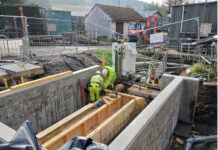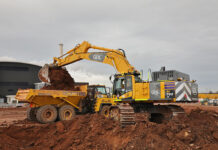
GIVEN that the purpose of offshore wind farms is to generate low-carbon, renewable energy, the concrete industry argues that the greenhouse gases emitted during their construction and operation should be given strong consideration.
A special interest group formed by MPA The Concrete Centre has carried out a study into the carbon footprint of gravity concrete foundation bases. The study, which considered only the foundation and not the turbine itself, examined the ‘cradle to grave’ resources used, from the construction of the manufacturing facility, through foundation construction, installation and maintenance to decommissioning and deconstruction. It compared the subsequent carbon footprint of concrete gravity bases with that of a steel jacket foundation.
The study was set against requirements for a deep water installation of a 5MW turbine at 42-metre depth, 50km offshore with a manufacturing facility to build a batch of 200 foundations and five units per visit for ballasting, scour and seabed preparation where required.
“This is a comprehensive study that set out to determine the CO2 impact of a concrete gravity base foundation against a comparable steel jacket foundation,” explained Andrew Minson, executive director of MPA The Concrete Centre.
The study found that the average carbon footprint for six different concrete gravity base solutions was an estimated 1,186 tonnes CO2 per unit, compared with an estimated steel jacket carbon footprint of 2,771 tones CO2. The findings, it said, further underline the low carbon attractiveness of wind farms as figures from Renewable UK show that the energy used for their manufacture and installation is paid back within three to six months.
The key driver for the significant difference in the carbon footprints was the quantum and type of steel used by the different solutions. The concrete gravity bases required significantly less steel than the steel jacket solution. Furthermore, the European reinforcement steel used in the concrete gravity bases is produced almost entirely from recycled metal and has a carbon factor based on Inventory of Carbon and Energy calculations of 0.45kg CO2/kg. This, said MPA, is in stark contrast to steel jacket foundations that use steel plate manufactured from virgin materials which has a carbon factor of 2.21kg CO2/kg.
In addition, some of the concrete solutions included a significant proportion of cement replacement material such as ground granulated blast furnace slag (GGBS) or pulverised fuel ash (PFA). Cement is a significant contributor to concrete’s carbon footprint. The use of replacement materials such as GBS and PFA can considerably reduce need for cement and, therefore, the resultant carbon footprint.
“This study suggests that concrete gravity bases have a significantly lower carbon footprint than steel jacket foundations”, said Minson. “This points to concrete gravity bases being a low carbon foundation solution that supports the ethos of offshore wind farms being a low carbon renewable energy source.”










